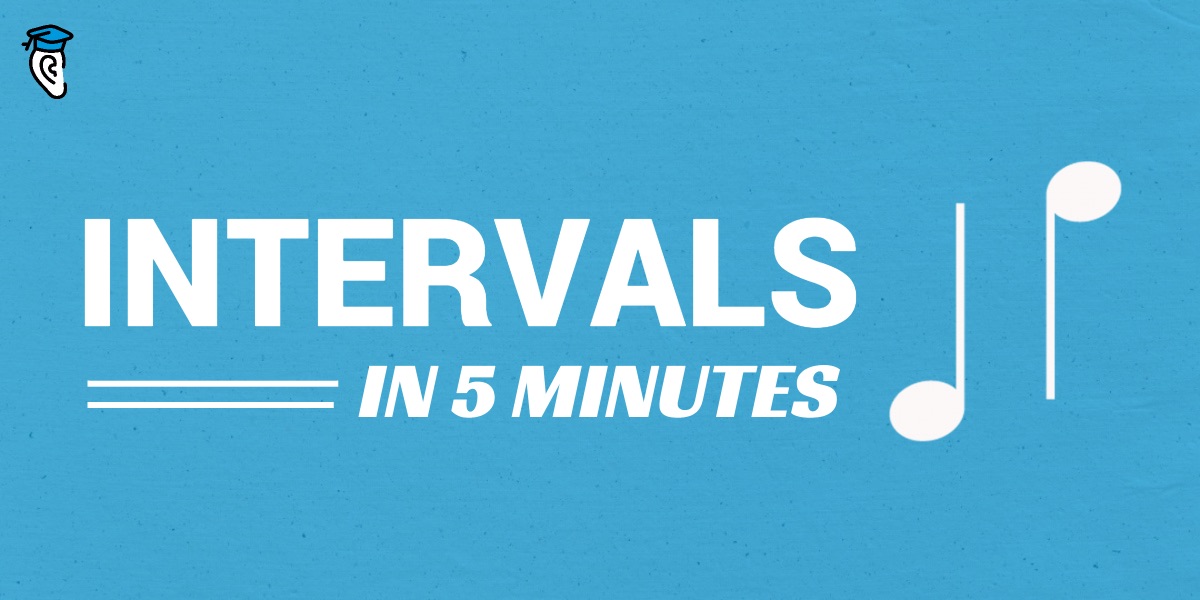Intervals are an essential skill for musicians, letting you easily play by ear, create your own music and improvise freely. But interval ear training can be confusing and overwhelming when you’re just getting started.
What if you could learn everything you need to know about intervals in just 5 minutes?
We took our Ultimate Guide to Interval Ear Training and condensed it down into just the essentials. Flip through the slides or read the text below and you’ll learn everything you need to know to become an interval master.
About Intervals
 What is an interval?
What is an interval?
An interval is the distance in pitch between two musical notes.
What’s the point of learning intervals?
Intervals are the building blocks of your sense of relative pitch, which lets you hear the pitch distances between notes. Relative pitch is how you play by ear and improvise.
What is “interval recognition”?
Recognising an interval means that you hear a pair of notes and you know how far apart in pitch they are. There are different names for the different distances.
What are the different types of interval?
There are 13 main types of interval, named for the scale degree they correspond to (e.g. “third”, “fourth”, “fifth”) and their “quality” which is normally “major”, “minor” or “perfect”. Here’s the list with the number of half-steps each one represents:
- Unison
- Semitone, Half-Step, or Minor Second
- Tone, Whole Step or Major Second
- Minor Third
- Major Third
- Perfect Fourth
- Tri-Tone
- Perfect Fifth
- Minor Sixth
- Major Sixth
- Minor Seventh
- Major Seventh
- Perfect Octave
What music theory do you need to know?
Just learn the names of each interval type. You can learn lots of detailed theory and how to “spell” each interval in each key, but you don’t need to in order to benefit from learning interval recognition.
What are “melodic” and “harmonic” intervals?
“Melodic” means played one note at a time, either ascending or descending in pitch. “Harmonic” means both notes are played together.
Learning Intervals
 How is it possible to recognise intervals?
How is it possible to recognise intervals?
Your ear recognises different types of interval by their distinctive sound and/or by the raw size of them.
How can people learn to recognise intervals?
There are three methods for interval ear training. Start with reference songs, then move on to solfa (do-re-mi) or pure recognition drills.
What are the most important intervals?
- Start by learning major and minor seconds, because they are the “stepping stones” the other intervals are built from and they’re the most common interval used between notes in melodies.
- Learn major and minor thirds because they’re important for chords and harmony (and also common in melodies).
- Learn perfect fourths and fifths because they’re important for harmony and especially for chord progressions.
What are “compound” intervals and do you need to learn them?
Compound intervals are bigger than an octave. You probably don’t need to worry about them, especially if you’re just starting out.
Where can you find good interval reference songs?
Google “interval reference songs” or follow these links to find interval reference songs that appeal to you:
- JustinGuitar.com
- vcu.edu
- ChoralNet
- fromthewoodshed.com
- YouTube videos like this one
- Modern interval reference songs
Figuring out your own reference songs is also a useful exercise in itself.
How do you learn intervals with solfa?
You learn the syllables which correspond, e.g. “do” up to “so” is a perfect fifth. There are exercises you can use to practice this.
 How do you learn intervals by “just doing it”?
How do you learn intervals by “just doing it”?
Download some ear training MP3s which demonstrate and test you on recognition. Or use interactive software: there are options for web, desktop and mobile.
Do you need to master certain intervals before moving on?
Mastery is not necessary. Be persitent, because it does take time and repetition to teach the brain new skills – but if you’ve been stuck for a while, moving on to something else can actually accelerate your overall progress.
What if you get stuck learning intervals?
Mix it up. Change the interval types you’re practising, change the instrument, find a new way to practice. Also, sing!
 Why does singing intervals help you learn them?
Why does singing intervals help you learn them?
There’s an intimate biological connection between brain, ears and voice. By singing intervals you teach your brain to judge their distances in a new and effective way. Also, having accurate singing pitch makes you a better musician.
Using Intervals
How do intervals help you recognise chords and progressions?
 The intervals between the notes in chords can help you recognise the chords. The intervals between the root notes of chords can help you recognise a progression. Fundamentally, intervals build your core ability to identify all the notes you hear.
The intervals between the notes in chords can help you recognise the chords. The intervals between the root notes of chords can help you recognise a progression. Fundamentally, intervals build your core ability to identify all the notes you hear.
 How do intervals help you improvise?
How do intervals help you improvise?
When you imagine the next note you want to play, intervals let you judge how far you need to jump from your last note to hit it.
 How do intervals help you play by ear?
How do intervals help you play by ear?
When you hear notes in music, interval recognition lets you judge how far apart they are from one another. So once you know the identity of one note (e.g. the melody starts on a C) you can figure out all the notes by ear.
That’s it! Everything you need to know to succeed with interval ear training. For more details see our Ultimate Guide to Interval Ear Training or explore the interval training modules available at Musical U.







